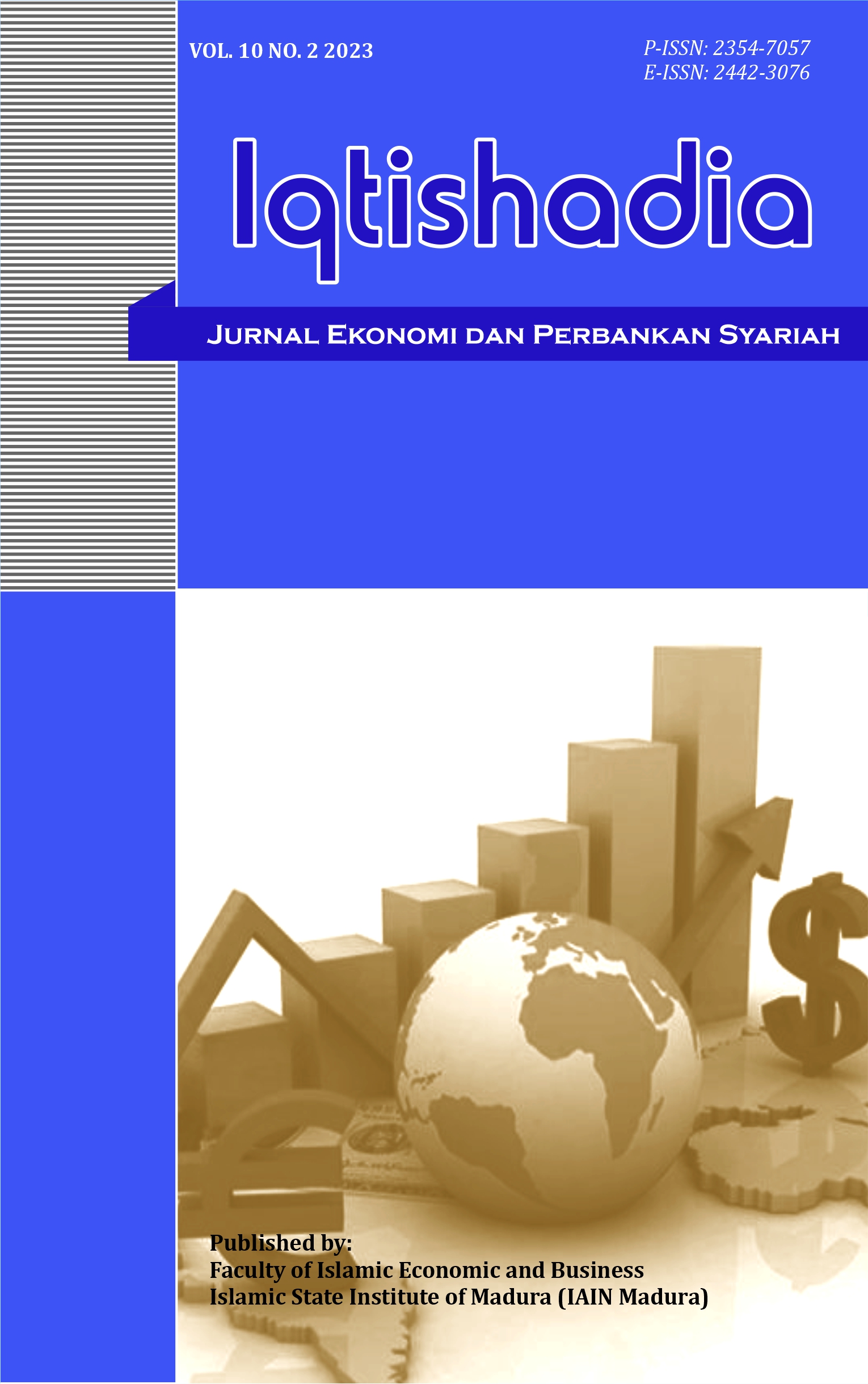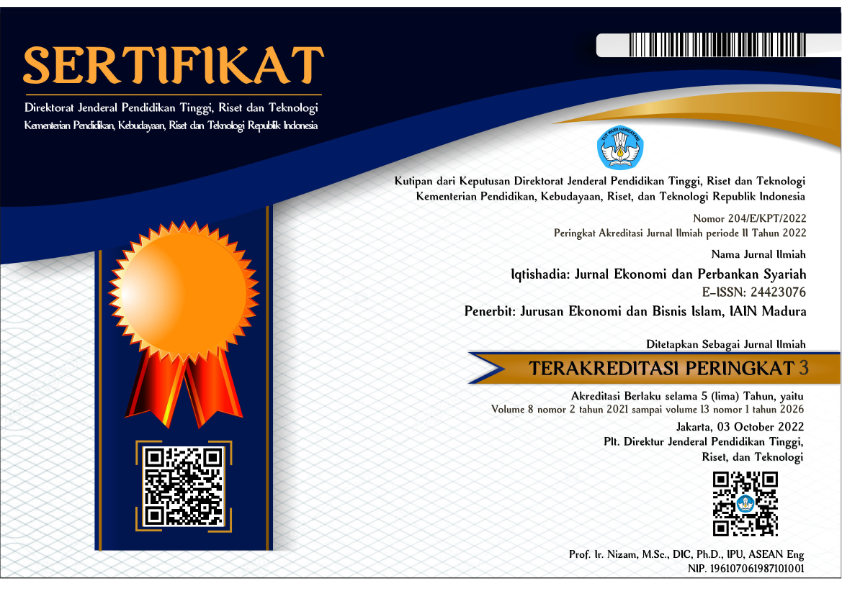Forecasting Money Flow in East Java Using The Generalized Space-Time Autoregressive With Exogenous Variable Method
 Abstract views: 275
,
Abstract views: 275
,
 PDF downloads: 192
PDF downloads: 192
Abstract
The forecast is more accurate when involving an exogen, for example, the generalized spatio temporal autoregressive (GSTAR) model with exogenous variables (GSTARX). This study aims to obtain appropriate statistical values to identify autoregressive orders for time dependencies and order effects with exogenous variables such as Eid al-Fitr and the consumer price index (CPI) in the GSTARX model. Additionally, this study seeks to obtain a GSTARX model suitable for forecasting. The case study is the inflows and outflows in four locations in East Java. The simulation results show that the statistical values for identifying VAR order for time dependencies use the matrix partial cross-correlation function (MPCCF). Meanwhile, effect orders from exogenous variables in the two-level GSTARX model show CCF at level one. In addition, GLS (general least squares) produces a more efficient estimator than the OLS (ordinary least squares). The results of the case study show that the two-level GSTAR model forming inflow and outflow data are GSTARX (31) and GSTARX ([1,3]1) respectively. In addition, the comparison of forecast accuracy shows that, in general, the smallest root mean square error (RMSE) value in the two-level GSTARX model is the inverse distance weight.
Downloads
References
Apriliadara, Meriska, Suhartono, and Dedy Dwi Prastyo. “VARI-X Model for Currency Inflow and Outflow Forecasting with Eid Fitr Effect in Indonesia.” AIP Conference Proceedings 1746, no. 1 (June 17, 2016): 020041. https://doi.org/10.1063/1.4953966.
Armstrong, Jon Scott. Principles of Forecasting: A Handbook for Researchers and Practitioners. Vol. 30. Springer Science & Business Media, 2001.
Astuti, Dewi, and Budi Nurani Ruchjana. “Generalized Space Time Autoregressive with Exogenous Variable Model and Its Application.” In Journal of Physics: Conference Series, 893:012038. IOP Publishing, 2017.
Bowerman, Bruce L., Richard T. O’Connell, and Anne B. Koehler. Forecasting, Time Series, and Regression: An Applied Approach. Thomson Brooks/Cole, 2005.
Box, George EP, Gwilym M. Jenkins, Gregory C. Reinsel, and Greta M. Ljung. Time Series Analysis: Forecasting and Control. John Wiley & Sons, 2015.
Chen, Chung, and Lon-Mu Liu. “Forecasting Time Series with Outliers.” Journal of Forecasting 12, no. 1 (1993): 13–35.
Gazali, Muhammad Munawir, and Dedy Dwi Prastyo. “VARX and GSTARX Models for Forecasting Currency Inflow and Outflow with Multiple Calendar Variations Effect.” Matematika 34 (2018).
Kariya, Takeaki, and Hiroshi Kurata. Generalized Least Squares. John Wiley & Sons, 2004.
Legal Information Team. “Surat Edaran Bank Indonesia Nomor 13/9/DPU Tanggal 5 April 2011 Perihal Penyetoran Dan Penarikan Uang Rupiah Oleh Bank Umum Di Bank Indonesia.” Directorate of Legal Affairs Bank Indonesia, 2011.
———. “Surat Edaran No.9/37/DPU Tanggal 27 Desember 2007 Tentang Penyetoran Dan Penarikan Uang Rupiah Oleh Bank Umum Di Bank Indonesia.” Bank Indonesia, 2007.
Manager of the Economic and Financial Assessment Division. “Kajian Ekonomi Regional Jawa Timur Triwulan I – 2014. Kantor Perwakilan Bank Indonesia Wilayah IV.” Kantor Perwakilan Bank Indonesia Wilayah IV, 2014.
Menke, William. “Review of the Generalized Least Squares Method.” Surveys in Geophysics 36, no. 1 (2015): 1–25.
Prastuti, M., L. Aridinanti, and W. P. Dwiningtyas. “Spatio-Temporal Models with Intervention Effect for Modelling the Impact of Covid-19 on the Tourism Sector in Indonesia.” Journal of Physics: Conference Series 1821, no. 1 (March 2021): 012044. https://doi.org/10.1088/1742-6596/1821/1/012044.
Ruchjana, Budi Nurani. “Pemodelan Kurva Produksi Minyak Bumi Menggunakan Model Generalisasi STAR.” In Forum Statistika Dan Komputasi, 01–06, 2002.
Seyyed, Fazal J., Abraham Abraham, and Mohsen Al-Hajji. “Seasonality in Stock Returns and Volatility: The Ramadan Effect.” Research in International Business and Finance 19, no. 3 (September 1, 2005): 374–83. https://doi.org/10.1016/j.ribaf.2004.12.010.
Suhartono, Novi Ajeng Salehah, Dedy Dwi Prastyo, and Santi Puteri Rahayu. “Hybrid ARIMAX Quantile Regression Model for Forecasting Inflow and Outflow of East Java Province.” Journal of Physics: Conference Series 1028, no. 1 (June 2018): 012228. https://doi.org/10.1088/1742-6596/1028/1/012228.
Suhartono, Sri Rizqi Wahyuningrum, Setiawan, and Muhammad Sjahid Akbar. “GSTARX-GLS Model for Spatio-Temporal Data Forecasting.” Malaysian Journal of Mathematical Sciences 10 (2016): 91–103.
Sullivan, Ryan, Allan Timmermann, and Halbert White. “Dangers of Data Mining: The Case of Calendar Effects in Stock Returns.” Journal of Econometrics 105, no. 1 (2001): 249–86.
Susanti, Ana, Hario Jati Setyadi, Medi Taruk, and Putut Pamilih Widagdo. “Forecasting Inflow and Outflow of Money Currency in East Java Using a Hybrid Exponential Smoothing and Calendar Variation Model.” In Journal of Physics: Conference Series, 979:012096. IOP Publishing, 2018.
Zellner, Arnold. “An Efficient Method of Estimating Seemingly Unrelated Regressions and Tests for Aggregation Bias.” Journal of the American Statistical Association 57, no. 298 (1962): 348–68.
The journal operates an Open Access policy under a Creative Commons Non-Commercial Share-Alike license. All articles published Open Access will be immediately and permanently free for everyone to read and download.
• Creative Commons Attribution-NonCommercial (CC-BY-NC)

Iqtishadia: Jurnal Ekonomi dan Perbankan Syariah by http://ejournal.iainmadura.ac.id/index.php/iqtishadia is licensed under a Creative Commons Attribution-NonCommercial 4.0 International License.
Based on a work at http://ejournal.iainmadura.ac.id.


























